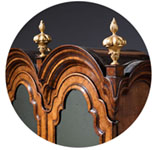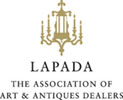17th Century Charles II Olive Oyster Floral Marquetry Table, Circa 1680-1690
Sold
Request Information
Follow Us
17th Century Charles II Olive Oyster Floral Marquetry Table, Circa 1680-1690
Floral marquetry inlaid olive oyster and ebony side table, attributed to Gerrit Jensen (fl.1667-1715), London, circa 1680. Incorporating Olive Oyster, ebony, stained bone, holly, figured olive walnut and tulip. The rectangular top is inlaid with a central panel of floral decoration incorporating birds within a cross-banded slip and a further floral inlaid border.
A single frieze drawer inlaid with conforming decoration raised on barley or as also known, Solomonic twist legs over an inlaid X stretcher raised on bun feet.
The attribution to Jensen derives from a group of floral marquetry furniture attributed to the cabinet maker, however, there is one table in particular held at Ham House that relates to this table more than any other. See images.
Jensen was almost certainly of Dutch origin and was known to be working in London from 1677 and at premises in St. Martin’s Lane by 1680 where he was described as a pre-eminent ‘Cabinet maker and Glasse seller’. Jensen was able to buy his way into the Joiners Company in 1667, probably at significant expense, thus proving his belief in his work and his establishment in London. From the early 1680s, he was the accredited cabinet maker to the Royal Household where several of his pieces remain, including a cushion frame mirror (RCIN 1383). A very similar mirror, almost certainly by Jensen, hangs at Ham House, Richmond, here three side tables, a strong box on stand and a cabinet are attributed on the basis In 1670s London, floral marquetry was a novelty, Reinier Baarsen suggests that it was this speciality work with which Jensen conquered the London clientele a few years later. Assuming his Dutch roots are accurate Jensen would have brought the art of floral marquetry with him from Holland to London, possibly via Paris after studying the work of the Frenchman Cornelius Gole, following Pierre Gole (c.1620-1685) in Paris and Leonardo van der Vinne (active c.1659-1713) in Florence.
In style, Jensen’s furniture is consistently French in form, and particularly close to the work of Pierre Golle, Boulle’s famous predecessor. Golle’s will mentions a sum of money owed to Jensen for glue suggesting that close contact existed between the two masters. The catalyst here may well have been Golle’s brother-in-law, Daniel Marot, the Huguenot designer and engraver trained under Bérain, who left France before the Revocation of the Edict of Nantes, entering the service of William and Mary first in Holland and then in England. Marot’s engraved furniture designs show remarkable similarities with Jensen’s documented pieces in the Royal Collection, and others attributed to him at Boughton, Drayton and elsewhere. It is possible that Jensen had French craftsmen working for him: for instance, one Peter Berew, who signs a receipt on his behalf at Drayton in 1693. French terms, barely anglicized, occur constantly in the accounts, and indeed the ‘beuro’ or ‘scrutore’ (escritoire) with ‘drawers to stand on the top’ (otherwise known as the ‘caddinet’) may be a form which Jensen introduced to this country from France, together with the narrow gateleg table with a folding top.
Gerrit Jensen was one of the foremost cabinet-makers of his day and worked in London from his premises in St. Martin’s Lane. Jensen served the English crown since the reign of Charles II as the accounts of the Royal Household record a payment to him in 1680, for furniture which King Charles II commissioned as a royal gift for the King of Morocco. In 1689, Jensen was appointed royal cabinetmaker to King William III and Queen Mary – ‘Cabinet maker in Ordinary’ to the Crown; and he retained his royal appointment throughout the reign of Queen Anne, supplying furniture for St. James’s Palace, Hampton Court and Kensington Palace. In addition to the Royal family and the Dukes of Devonshire, Jensen also attracted commissions from senior members of the nobility, including the Dukes of Richmond, Hamilton, Montagu and Somerset, collaborating with other leading artists and craftsmen on the decoration of some of the greatest town and country houses in England. Jensen was one of several artist-craftsmen of foreign background employed at the English court, and his work shows a strong Continental influence, reflecting the fashionable French court styles of Pierre Golle, André Charles Boulle and Daniel Marot earning him the title ‘the English Boulle’.
Condition
Good. Wear consistent with age and use.
Dimensions
Height: 71.5 cm (28.15 in)
Width: 94 cm (37.01 in)
Depth: 63.5 cm (25.01 in)
PREVIOUSLY SOLD

George III Walnut and Sycamore Comb-back Windsor Chair
The chair is of generous proportions having a large ‘saddle’ style seat carved from a single piece of walnut, surrounded by a gallery back, steam bent horseshoe armrest and solid cabriole legs.
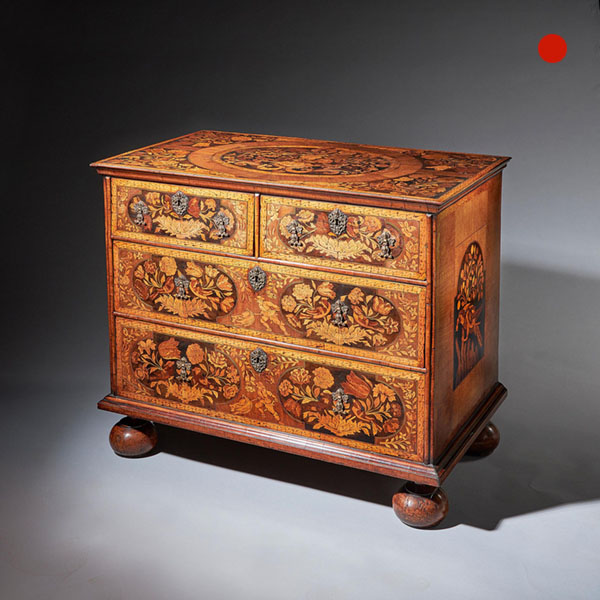
William and Mary Marquetry Chest of Drawers
A William and Mary walnut floral marquetry chest, circa 1690. The rectangular ogee moulded top with central banded oval inlaid with spring flowers, birds and scrolls of acanthus, on ebony ground.
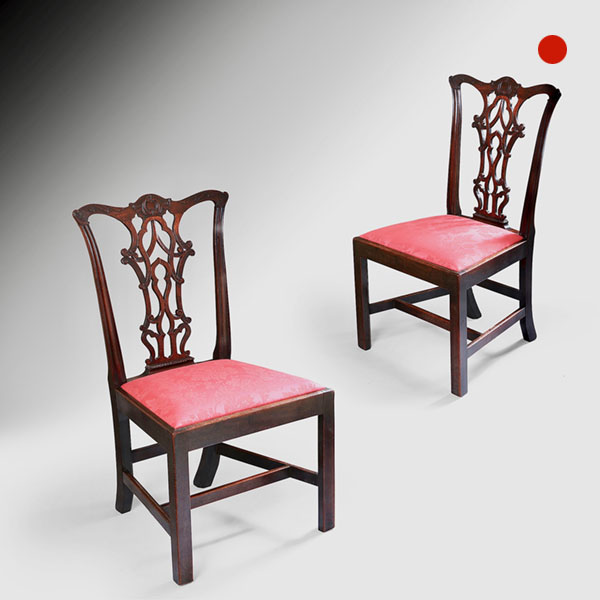
Pair of George III Mahogany Chairs
A fabulous pair of George III mahogany chairs in original ‘country house’ condition. The carved cresting rail is decorated with sweeping softly carved acanthus leaves and centred by a cartouche.
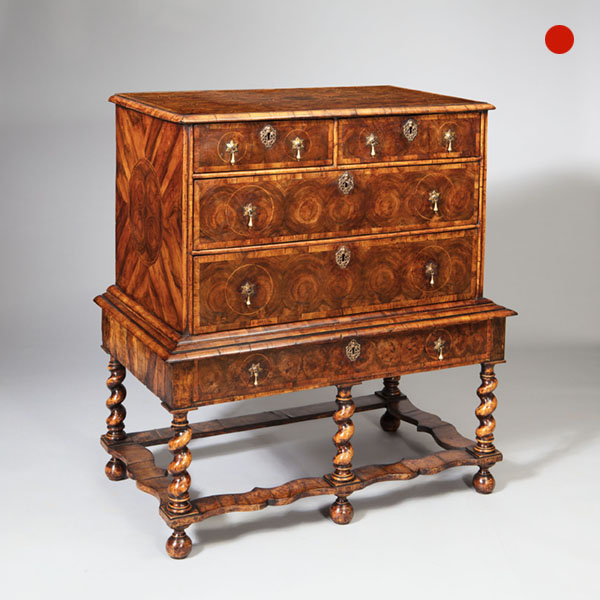
17th-Century William and Mary Olive Oyster Chest of Drawers on Stand
A superb example of well-chosen hand-cut olive oyster veneers, combined with the finesse of a highly skilled craftsman, from the reign of William & Mary (1689-1702).

George I Gilt Gesso Mirror
IMPORTANT DESIGN – A fine early 18th-century gilt gesso mirror of generous proportions retaining its original shaped and bevelled mirror plate. The frame expresses great freedom through its carving with scrolling leaves adorning the frame centred by an elaborate three-dimensional cartouche.
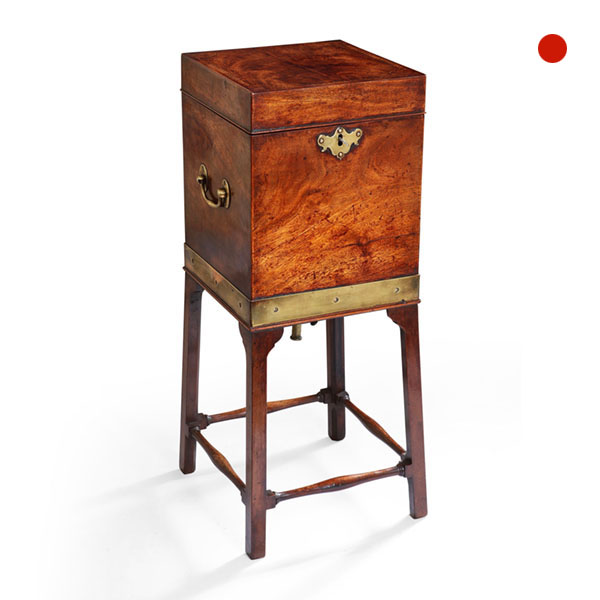
George III Mahogany Wine Cooler, Cellarette
Superb George III mahogany wine cooler or cellarette on stand. The cellarette is in fabulous original condition with a lovely rich patina. Lovely well-patinated flame of mahogany to the top, with a line rope inlayed stringing of holly and box. Original led lined interior divided into four sections.

George III Walnut and Sycamore Comb-back Windsor Chair
The chair is of generous proportions having a large ‘saddle’ style seat carved from a single piece of walnut, surrounded by a gallery back, steam bent horseshoe armrest and solid cabriole legs.

William and Mary Marquetry Chest of Drawers
A William and Mary walnut floral marquetry chest, circa 1690. The rectangular ogee moulded top with central banded oval inlaid with spring flowers, birds and scrolls of acanthus, on ebony ground.

Pair of George III Mahogany Chairs
A fabulous pair of George III mahogany chairs in original ‘country house’ condition. The carved cresting rail is decorated with sweeping softly carved acanthus leaves and centred by a cartouche.

17th-Century William and Mary Olive Oyster Chest of Drawers on Stand
A superb example of well-chosen hand-cut olive oyster veneers, combined with the finesse of a highly skilled craftsman, from the reign of William & Mary (1689-1702).

George I Gilt Gesso Mirror
IMPORTANT DESIGN – A fine early 18th-century gilt gesso mirror of generous proportions retaining its original shaped and bevelled mirror plate. The frame expresses great freedom through its carving with scrolling leaves adorning the frame centred by an elaborate three-dimensional cartouche.

George III Mahogany Wine Cooler, Cellarette
Superb George III mahogany wine cooler or cellarette on stand. The cellarette is in fabulous original condition with a lovely rich patina. Lovely well-patinated flame of mahogany to the top, with a line rope inlayed stringing of holly and box. Original led lined interior divided into four sections.
YOU MAY ALSO LIKE
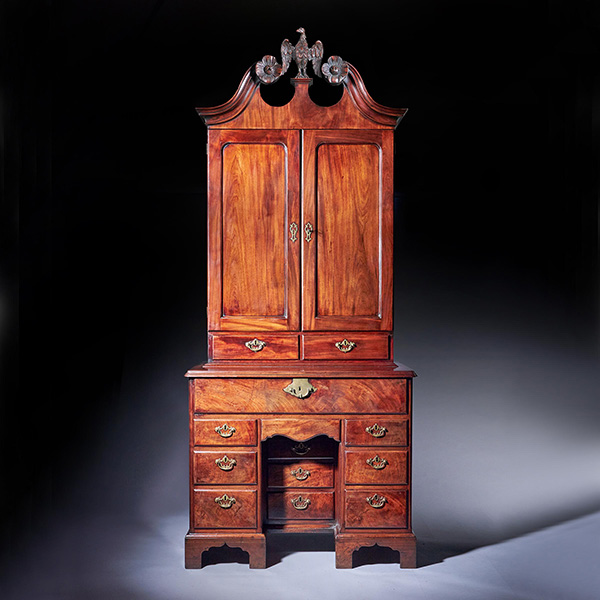
A George II Irish Mahogany Secretaire Kneehole Bookcase Att. C. Hearn
A George II Irish Mahogany Secretaire Kneehole Bookcase Att. C. Hearn £45,900Follow UsA George II Irish Mahogany Secretaire Kneehole Bookcase Att. C. Hearn An original and rare two-part George II 18th century Irish architects figured mahogany...

17th Century Lantern Alarm Clock by Johannes Quelch, Oxford
17th Century Lantern Alarm Clock by Johannes Quelch, Oxford £14,000Follow Us17th Century Lantern Alarm Clock by Johannes Quelch, Oxford An English 17th century lantern clock made of brass and iron, circa 1665-1670. The clock consists of going...
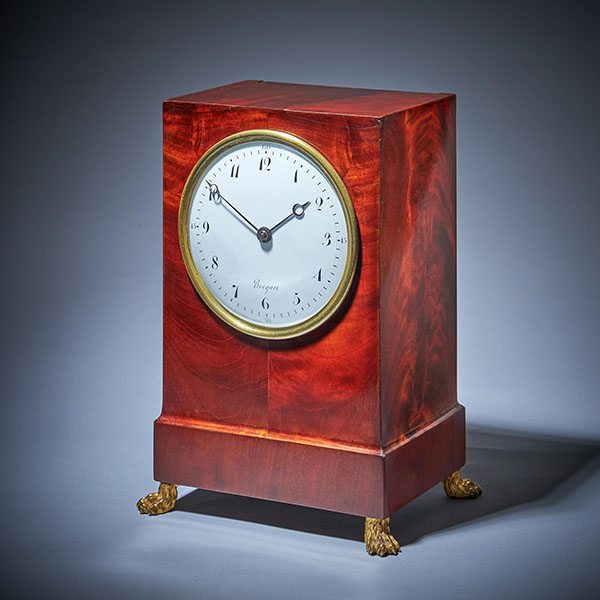
19th-Century Flame Mahogany Mantel Clock by BREGUET Raised by Lion Paw Feet
19th-Century Flame Mahogany Mantel Clock by BREGUET Raised by Lion Paw Feet £23,500Follow Us19th-Century Flame Mahogany Mantel Clock by BREGUET Raised by Lion Paw Feet EXTREMELY RARE MANTEL CLOCK WITH A FIGURED MAHOGANY-VENEERED CASE by A-L...

Unusual Ribbed Eight-Day Repeating Striking Gilt-Brass Gorge Case Carriage Clock
Unusual Ribbed Eight-Day Repeating Striking Gilt-Brass Gorge Case Carriage Clock £4,850Follow UsUnusual Ribbed Eight-Day Repeating Striking Gilt-Brass Gorge Case Carriage Clock CaseThe clock has a gilt-brass case which is a variation on the...
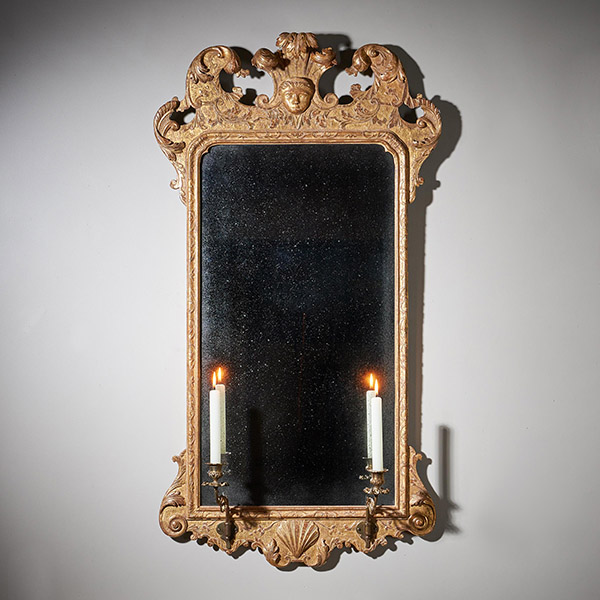
Fine 18th Century George I Gilt Gesso Pier or Console Mirror, Manner of Belchier
Fine 18th Century George I Gilt Gesso Pier or Console Mirror, Manner of Belchier £13,900Follow UsFine 18th Century George I Gilt Gesso Pier or Console Mirror, Manner of Belchier A fine and rare early 18th century George I Gilt Gesso pier or...
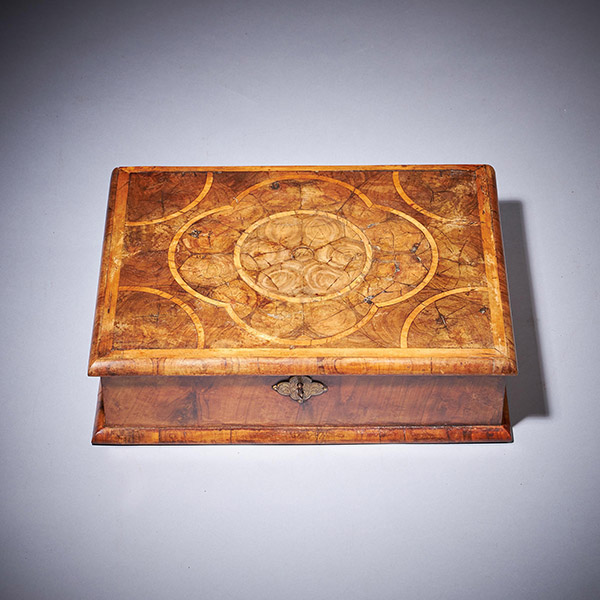
17th Century William and Mary Olive Oyster Lace Box, Circa 1680-1700
17th Century William and Mary Olive Oyster Lace Box, Circa 1680-1700 £3,900Follow Us17th Century William and Mary Olive Oyster Lace Box, Circa 1680-1700 A fine and rare 17th-century William and Mary period olive oyster lace box of perfect...

A George II Irish Mahogany Secretaire Kneehole Bookcase Att. C. Hearn
A George II Irish Mahogany Secretaire Kneehole Bookcase Att. C. Hearn £45,900Follow UsA George II Irish Mahogany Secretaire Kneehole Bookcase Att. C. Hearn An original and rare two-part George II 18th century Irish architects figured mahogany...

17th Century Lantern Alarm Clock by Johannes Quelch, Oxford
17th Century Lantern Alarm Clock by Johannes Quelch, Oxford £14,000Follow Us17th Century Lantern Alarm Clock by Johannes Quelch, Oxford An English 17th century lantern clock made of brass and iron, circa 1665-1670. The clock consists of going...

19th-Century Flame Mahogany Mantel Clock by BREGUET Raised by Lion Paw Feet
19th-Century Flame Mahogany Mantel Clock by BREGUET Raised by Lion Paw Feet £23,500Follow Us19th-Century Flame Mahogany Mantel Clock by BREGUET Raised by Lion Paw Feet EXTREMELY RARE MANTEL CLOCK WITH A FIGURED MAHOGANY-VENEERED CASE by A-L...

Unusual Ribbed Eight-Day Repeating Striking Gilt-Brass Gorge Case Carriage Clock
Unusual Ribbed Eight-Day Repeating Striking Gilt-Brass Gorge Case Carriage Clock £4,850Follow UsUnusual Ribbed Eight-Day Repeating Striking Gilt-Brass Gorge Case Carriage Clock CaseThe clock has a gilt-brass case which is a variation on the...

Fine 18th Century George I Gilt Gesso Pier or Console Mirror, Manner of Belchier
Fine 18th Century George I Gilt Gesso Pier or Console Mirror, Manner of Belchier £13,900Follow UsFine 18th Century George I Gilt Gesso Pier or Console Mirror, Manner of Belchier A fine and rare early 18th century George I Gilt Gesso pier or...

17th Century William and Mary Olive Oyster Lace Box, Circa 1680-1700
17th Century William and Mary Olive Oyster Lace Box, Circa 1680-1700 £3,900Follow Us17th Century William and Mary Olive Oyster Lace Box, Circa 1680-1700 A fine and rare 17th-century William and Mary period olive oyster lace box of perfect...
